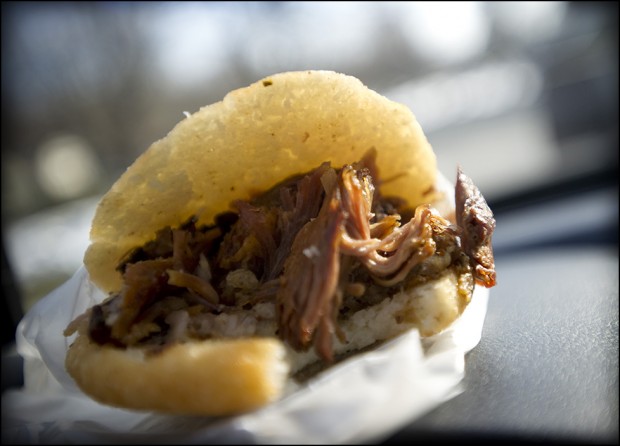 At the Venezuelan Beach Cafe in Norwalk, Connecticut, arepas were flying out the door like hotcakes. Weekending in Connecticut, we stumbled upon a tiny place across the laundromat on Main Street. On a desolate block, on a sunny Sunday morning, stood small pockets of hungry people willing to queue up for almost an hour. Including us. I can't remember a time when my husband and I would have ever stood on line. Our 14-year old daughter had the patience of a saint and we all enjoyed moving into the cafe to hug the wall and marvel at each plate that went by. There were all shades of pastel batidos -- fresh fruit milk shakes -- that made your mouth water. On each table were two large squeeze bottles whose contents people were showering over their chilaquiles, arepas, empanandas, and some of the more newfangled dishes that were "specials" that day. In one plastic bottle was a thick chipotle sauce that looked like chocolate ketchup (it was delicious) and in the other, a piquant avocado-cilantro sauce (even more delicious!) known as guasacaca sauce. I will try to duplicate it today and share it with you tomorrow for it is completely new to me and something I'd like to eat often. Apparently, this sauce is popular in Venezuelan steakhouses, but I am dreaming about it on steamed salmon, tossed with leafy greens, drizzled on grilled chicken, and spooned atop slices of thick, charred hanger steak. But I digress.
At the Venezuelan Beach Cafe in Norwalk, Connecticut, arepas were flying out the door like hotcakes. Weekending in Connecticut, we stumbled upon a tiny place across the laundromat on Main Street. On a desolate block, on a sunny Sunday morning, stood small pockets of hungry people willing to queue up for almost an hour. Including us. I can't remember a time when my husband and I would have ever stood on line. Our 14-year old daughter had the patience of a saint and we all enjoyed moving into the cafe to hug the wall and marvel at each plate that went by. There were all shades of pastel batidos -- fresh fruit milk shakes -- that made your mouth water. On each table were two large squeeze bottles whose contents people were showering over their chilaquiles, arepas, empanandas, and some of the more newfangled dishes that were "specials" that day. In one plastic bottle was a thick chipotle sauce that looked like chocolate ketchup (it was delicious) and in the other, a piquant avocado-cilantro sauce (even more delicious!) known as guasacaca sauce. I will try to duplicate it today and share it with you tomorrow for it is completely new to me and something I'd like to eat often. Apparently, this sauce is popular in Venezuelan steakhouses, but I am dreaming about it on steamed salmon, tossed with leafy greens, drizzled on grilled chicken, and spooned atop slices of thick, charred hanger steak. But I digress.
Some of you may not know about arepas. They are thick corncakes made from precooked corn flour, that are fried, grilled or baked and often filled like a sandwich. They were originally made in Venezuela and Colombia and stuffed or simply topped with butter and cheese. At the Venezuelan Beach Cafe, the arepas were about 5 inches in diameter, moist, and crispy on the outside. I had mine filled with pernil -- garlic-and-parsley roasted pork which is ubiquitous in many of the dishes at VBC and in much of Latin and South America. I have a recipe for arepas in one of my cookbooks from the mid 1990's -- before they were ever popular and certainly before little arepias hit the streets of Brooklyn and Williamsburg. They are now the rage. What I didn't know back then was the correct flour to use. I will try making them, more authentically this time, with masarepa, or masa precocida. My daughter loved her "little piggy french toast" filled with pernil, OE eggs (over-easy), bacon and American cheese. Oh my. She then invented a batido of her own: Pineapple-vanilla. The waiter smiled when he served it to her.
The real name of the restaurant is Valencia Luncheria, although the hand-crafted sign on the front of the building said "Venezuelan Beach Food" or cafe. Can't remember exactly. It is located at 172 Main Street in Norwalk, Connecticut. It is, however, open for early breakfast, lunch and dinner. Next time we'll bring a bottle of wine and try those gorgeous steamed clams with arepas for dunking. Corkage? $5 a bottle. tel: 203-846-8009